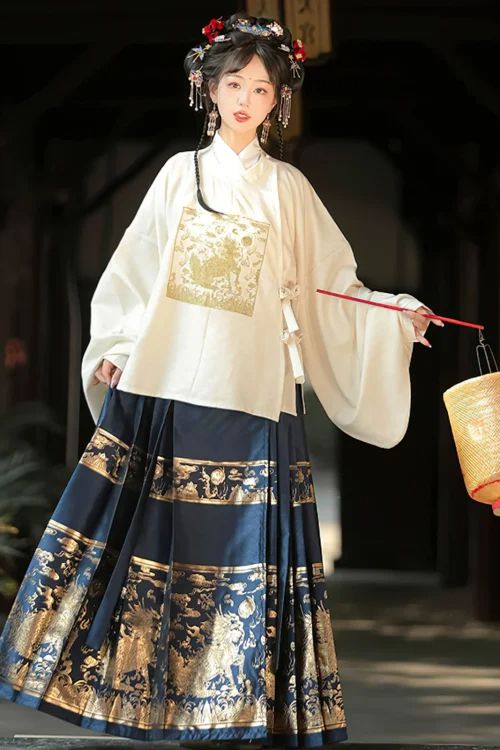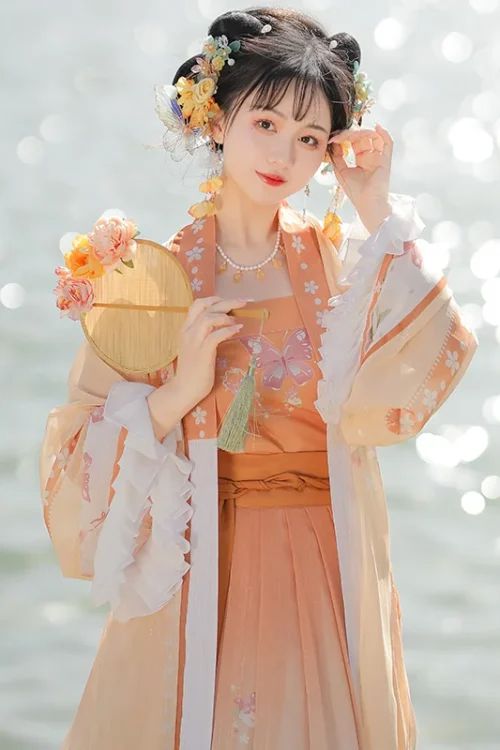Introduction to the Ruyi Pattern in 汉服
The Ruyi pattern, an auspicious symbol deeply rooted in Chinese culture, has found its way onto the elegant garments of Hanfu, the traditional clothing of the Han Chinese. Its presence on Hanfu adds an air of refinement and conveys a wealth of cultural significance.

Symbolism of the Ruyi Pattern
The Ruyi pattern, often depicted as a stylized cloud or fungus, symbolizes good fortune, prosperity, and the fulfillment of wishes. Its name, “Ruyi,” translates to “as you wish” or “according to your heart’s desire.” This auspicious meaning has made it a popular motif in various forms of Chinese art and architecture.
Placement and Design on Hanfu
In Hanfu, the Ruyi pattern is commonly found on the edges of garments, such as sleeves, hems, and collars. It can also be incorporated into the fabric itself through embroidery or weaving. The placement of the pattern is not arbitrary; it is often positioned in areas that are visible and eye-catching, such as the front of the garment or the cuffs.
Symbolic Role in Hanfu
The Ruyi pattern on Hanfu serves not only as a decorative element but also as a symbol of the wearer’s hopes and aspirations. It is believed that by wearing garments adorned with the Ruyi pattern, one can attract good fortune and ward off evil spirits. This belief has made the Ruyi pattern a popular choice for ceremonial and festive occasions, such as weddings and festivals.
Elegance and Sophistication in Design
In addition to its auspicious symbolism, the Ruyi pattern also adds a touch of elegance and sophistication to Hanfu. Its intricate curves and flowing lines create a sense of movement and dynamism, enhancing the overall aesthetic appeal of the garment. The pattern’s versatility allows it to be incorporated into various Hanfu styles, from the flowing robes of the Tang dynasty to the more structured garments of the Ming dynasty.
Cultural Significance and Legacy
The application of the Ruyi pattern on Hanfu is a testament to the enduring cultural significance of this auspicious symbol. It not only adds beauty and refinement to the garments but also conveys a wealth of cultural meaning and symbolism. By wearing Hanfu adorned with the Ruyi pattern, individuals can express their hopes for good fortune and prosperity while connecting with the rich traditions of Chinese culture.
The Evolution of the Ruyi Pattern in Hanfu Design
The Ruyi pattern, an auspicious symbol of good fortune and prosperity, has played a significant role in Chinese culture for centuries. Its intricate design, often featuring stylized clouds, bats, and other auspicious motifs, has found expression in various art forms, including Hanfu, the traditional clothing of the Han Chinese.
The application of the Ruyi pattern on Hanfu can be traced back to the Ming dynasty (1368-1644). During this period, the Ruyi pattern became increasingly popular in textile design, and its use on Hanfu garments symbolized the wearer’s aspirations for good fortune and prosperity. The pattern was often incorporated into the borders, cuffs, and collars of Hanfu robes, adding an element of elegance and auspiciousness to the attire.

The Qing Dynasty and the Ruyi Pattern
In the Qing dynasty (1644-1912), the Ruyi pattern continued to be widely used on Hanfu. However, its design underwent some modifications, becoming more elaborate and stylized. The pattern was often combined with other auspicious motifs, such as the dragon, phoenix, and lotus, to create visually stunning and meaningful designs.
Incorporation into Hanfu Accessories
The Ruyi pattern also found its way into the accessories worn with Hanfu. Hairpins, earrings, and other jewelry often featured the Ruyi motif, symbolizing the wearer’s hopes for good fortune and prosperity. Additionally, the Ruyi pattern was used in the design of fans, which were an essential accessory for both men and women in traditional Chinese society.
The Ruyi Pattern in Modern Times
In contemporary times, the Ruyi pattern continues to be an important element in Hanfu design. 现代汉服 enthusiasts often incorporate the pattern into their garments, paying homage to the rich cultural heritage of the Han Chinese. The Ruyi pattern serves as a reminder of the auspicious wishes and aspirations that have been associated with it for centuries.
Influence of the Ruyi Pattern Beyond Hanfu
Moreover, the Ruyi pattern has also found its way into other aspects of modern Chinese culture. It is often used in interior design, architecture, and other decorative arts, symbolizing good fortune and prosperity in various contexts. The enduring popularity of the Ruyi pattern is a testament to its timeless appeal and cultural significance.
The Cultural Significance of the Ruyi Pattern in Hanfu
The Ruyi pattern, an auspicious symbol deeply rooted in Chinese culture, has found its way onto the elegant garments of Hanfu, the traditional clothing of the Han Chinese. Its presence on Hanfu adds a layer of cultural significance and aesthetic charm.

The Symbolism of the Ruyi Pattern
The Ruyi pattern, often depicted as a stylized cloud or fungus, represents good fortune, prosperity, and power. Its name, “Ruyi,” translates to “as you wish,” embodying the hope that all desires will be fulfilled. In Hanfu, the Ruyi pattern is commonly found on the sleeves, hems, and collars, adding a touch of auspiciousness to the wearer.
Application of the Ruyi Pattern in Hanfu
The application of the Ruyi pattern on Hanfu varies depending on the garment’s style and occasion. For formal attire, such as wedding gowns and ceremonial robes, the Ruyi pattern is often embroidered in intricate gold or silver threads, creating a luxurious and auspicious effect. In everyday wear, the pattern may be printed or woven into the fabric, adding a subtle touch of elegance.
Ruyi Pattern as a Cultural Identifier
Beyond its aesthetic appeal, the Ruyi pattern on Hanfu also serves as a cultural identifier. It connects the wearer to the rich traditions and beliefs of Chinese culture. By incorporating this auspicious symbol into their clothing, Hanfu enthusiasts express their respect for their heritage and their hopes for a prosperous future.
Ruyi Pattern in Cultural Exchange
Furthermore, the Ruyi pattern on Hanfu has become a symbol of cultural exchange and appreciation. As Hanfu gains popularity worldwide, the Ruyi pattern has introduced Chinese culture to a global audience. It has inspired designers and fashion enthusiasts to incorporate this auspicious symbol into their own creations, fostering a deeper understanding and appreciation of Chinese heritage.
Conclusion: Enduring Significance of the Ruyi Pattern
In conclusion, the application of the Ruyi pattern on Hanfu is not merely a decorative element but a profound expression of cultural significance. It represents the hopes and aspirations of the Han Chinese people, connects them to their heritage, and serves as a symbol of cultural exchange and appreciation. As Hanfu continues to evolve and gain recognition, the Ruyi pattern will undoubtedly remain an integral part of its rich tapestry, embodying the enduring spirit of Chinese culture.
